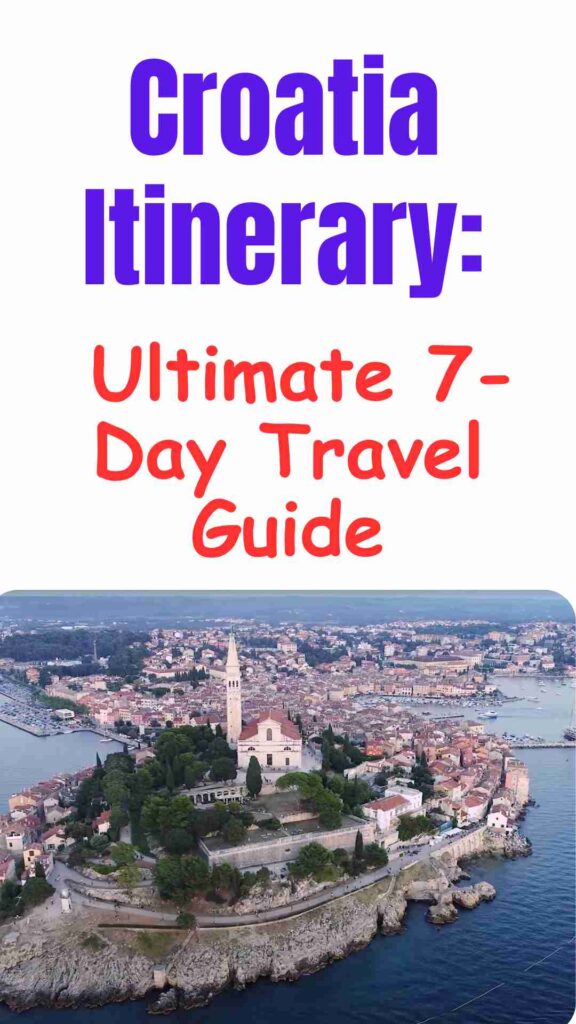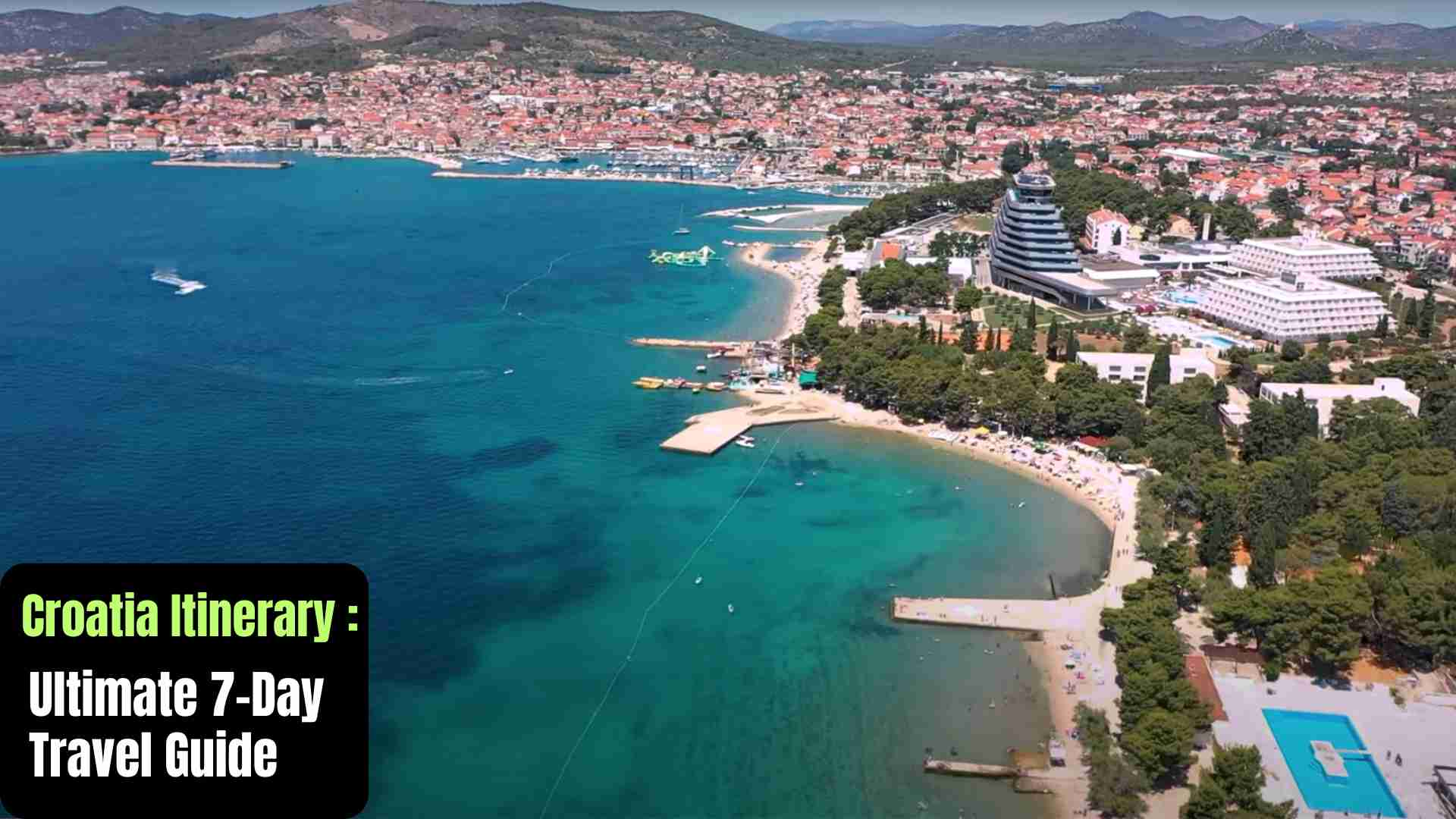Why Visit Croatia in 7 Days?
Imagine waking up to the sound of waves crashing on the Adriatic coast, wandering through medieval towns that feel like movie sets, and ending your day with fresh seafood and sunset views. That’s Croatia for you—a stunning mix of history, culture, and nature, all packed into a country you can easily explore in a week.
This Croatia itinerary is designed for first-time travelers who want to see the best of the country in just 7 days. It’s ideal for couples, solo adventurers, or even families who enjoy a mix of cities, coastal towns, and islands. We’ll cover the must-see places while keeping travel time manageable and allowing for meaningful experiences—not just photo stops.
How This Itinerary Works
This 7-day Croatia travel guide begins in the inland capital of Zagreb and finishes in the coastal gem of Dubrovnik, following a north-to-south route. You’ll visit iconic spots like Plitvice Lakes, the Roman ruins of Split, and the magical island of Hvar. Expect short drives, ferry rides, and a few early mornings—but the views will be worth it.
If you prefer to reverse the trip and start from Dubrovnik, that’s totally fine. Flights and rental cars are easy to book from either end.
Day 1: Arrive in Zagreb – A Taste of Croatian Culture
Why Start Here: Zagreb isn’t usually the highlight of Croatia itineraries, but it’s a charming and underrated starting point. The city feels cozy and relaxed, with friendly locals, quirky museums, and colorful streets. It’s also well-connected for international flights and has fewer tourist crowds than the coast.

Morning:
Arrive in Zagreb and settle into a centrally located hotel or guesthouse. Most major sites are within walking distance in the old town.
Start your adventure with a walk through Ban Jelačić Square, the city’s main hub. Grab a coffee at one of the cafés along Tkalčićeva Street—Zagreb has a serious café culture. It’s not just about the drink; it’s about slowing down and soaking in the vibe.
Afternoon:
Visit the Museum of Broken Relationships—yes, it’s exactly what it sounds like. This quirky museum showcases items and stories from failed romances around the world, and it’s surprisingly touching.
Then, head to St. Mark’s Church, with its colorful tiled roof, and take in panoramic views from Lotrščak Tower. Don’t miss the daily cannon firing at noon!
Evening:
Enjoy a traditional Croatian dinner at Stari Fijaker or Didov San. Dishes like peka (meat or seafood slow-cooked under a bell-shaped lid) or štrukli (cheese-filled pastry) are worth trying.
If you’re up for it, explore the Upper Town by night—it’s quiet, romantic, and full of little surprises like street art, lantern-lit alleys, and the occasional live music performance.
Where to Stay in Zagreb:
- Budget: Swanky Mint Hostel
- Mid-range: Hotel Jägerhorn
- Luxury: Esplanade Zagreb Hotel
Day 2: Plitvice Lakes National Park – A Waterfall Wonderland
Why Go:
Plitvice Lakes is one of Croatia’s most breathtaking natural sites. With 16 cascading lakes and dozens of waterfalls, it feels like something out of a fantasy movie. It’s also a UNESCO World Heritage site and absolutely worth the detour.
Morning:
Leave Zagreb early (around 7 AM) to make the most of the day. The drive to Plitvice Lakes takes around 2 hours. Try to arrive before 9 AM to beat the crowds—especially in summer.
Buy your entrance ticket online in advance. Choose Entrance 1 or 2 depending on your route preference. If it’s your first time, stick with Route C (from Entrance 1) for a full-circle trail that takes 4–5 hours and includes a short boat ride across the lower lakes.
Afternoon:
Bring a packed lunch or grab a bite at one of the park’s small cafés. You’ll want to keep moving because there’s so much to see—emerald green waters, wooden walkways, fish swimming underfoot, and waterfalls at every turn. Wear sturdy shoes and bring water.
Evening:
After exploring the park, drive to Zadar (approx. 1.5–2 hours away). Check into your hotel and treat yourself to a relaxing dinner by the sea. Zadar is a coastal city with a laid-back vibe and fewer crowds than Split or Dubrovnik.
Where to Stay in Zadar:
- Budget: The Lazy Monkey Hostel
- Mid-range: Teatro Verdi Boutique Hotel
- Luxury: Falkensteiner Hotel & Spa Iadera (just outside the city)
Day 3: Zadar – Roman Ruins, Sea Organ & Sunset Magic
Why Zadar Stands Out:
Zadar blends ancient history with modern art in a way that feels totally unique. It’s not overly touristy but still has plenty to explore, making it a perfect overnight stop on your Croatia itinerary.
Morning:
Start your day with a stroll through the Old Town, built on a peninsula. You’ll see Roman ruins, medieval churches, and vibrant local markets all in a compact area.
Visit the Church of St. Donatus, one of Croatia’s most iconic landmarks, and wander through the Roman Forum. If you love history, the Archaeological Museum offers deeper insight into the region’s past.
Afternoon:
Make your way to the Sea Organ, a one-of-a-kind instrument played by the movement of the waves. Right next to it is the Greeting to the Sun, a solar-powered art installation that comes alive at night.
Before that, relax with a gelato or take a dip in the sea near Kolovare Beach. Zadar has several swimmable spots just steps from the city center.
Evening:
Don’t miss what Alfred Hitchcock once called “the most beautiful sunset in the world.” The waterfront promenade fills with both locals and travelers in the evening, and the vibe is mellow and magical.
Enjoy dinner at Pet Bunara for seasonal Dalmatian dishes, or grab something quick and tasty at Konoba Skoblar.
Day 4: Split – Ancient Palaces and Adriatic Vibes
Why Visit Split:
Split is Croatia’s second-largest city and feels alive with history and energy. It’s not just a base for ferries—this city is built around a real Roman palace that’s still fully lived in today. If you love architecture, culture, and bustling waterfronts, Split delivers.
Morning:
Arrive in Split from Zadar (about 2 hours by car or bus). Head straight to the beating heart of the city—Diocletian’s Palace. This 4th-century palace complex is a UNESCO World Heritage site, but it doesn’t feel like a museum. Locals live, work, and dine inside its walls.
Start your walking tour at the Golden Gate, then explore the Peristyle, St. Domnius Cathedral, and the Cellars. Don’t be surprised if you hear live music echoing off the stone—it adds to the charm.
Afternoon:
Climb the bell tower for panoramic views of Split and the nearby islands. Afterward, wander through Pjaca Square, browse artisan shops, or grab a light lunch at Bokeria Kitchen & Wine Bar or Villa Spiza.
If you’re up for it, take a walk or rent a bike to explore Marjan Hill. This pine-covered park offers quiet trails and scenic overlooks. You’ll get a whole new view of the city from above.
Evening:
End your day at the Riva Promenade, a lively waterfront stretch filled with palm trees, cafés, and people-watching opportunities. Try local seafood dishes like grilled branzino or black risotto at Konoba Fetivi.
Where to Stay in Split:
- Budget: En Route Hostel
- Mid-range: Heritage Hotel Santa Lucia
- Luxury: Hotel Park Split
Day 5: Hvar Island – Chic, Sunny, and Full of Charm
Why Hvar:
Hvar is known for its sunshine, lavender fields, and elegant harbor town. It’s often called the “St. Tropez of Croatia,” but it’s not just for the yacht crowd. You’ll find culture, beaches, and laid-back villages, too.
Morning:
Catch a morning ferry from Split to Hvar Town (usually 1–1.5 hours). Book your ferry in advance, especially during summer months. Upon arrival, you’ll be welcomed by a stunning waterfront lined with boats, restaurants, and medieval walls.
Start with a walk through the town center. Climb up to Fortica Fortress (Španjola) for jaw-dropping views of the harbor and nearby Pakleni Islands.
Afternoon:
Have lunch at Dalmatino, then choose how you want to spend the afternoon:
- Beach Time: Head to Pokonji Dol Beach or take a water taxi to Jerolim Island for a more secluded swim.
- Adventure Option: Rent a scooter and visit charming inland villages like Velo Grablje or explore the lavender fields (best in late June/early July).
- Wine & Chill: Visit Tomić Winery in Jelsa for a tasting session, or simply relax with a drink at one of Hvar Town’s stylish cafés.
Evening:
Hvar comes alive at night but stays classy. Enjoy seafood pasta or gregada (traditional fish stew) at Black Pepper or Giaxa. If you’re in the mood, grab a cocktail at Hula Hula Bar or Carpe Diem, but don’t worry—there’s always a quiet corner for a calm evening, too.
Where to Stay in Hvar Town:
- Budget: Youth Hostel Villa Marija
- Mid-range: Hotel Park Hvar
- Luxury: Palace Elisabeth, Hvar Heritage Hotel
Day 6: Korčula – The Quiet Charmer of the Adriatic
Why Visit Korčula:
Often overshadowed by Hvar and Dubrovnik, Korčula is a hidden gem. Known as the birthplace of Marco Polo (or so the locals claim), it offers old-world charm, crystal-clear water, and a more relaxed, authentic vibe.
Morning:
Take an early catamaran or ferry from Hvar to Korčula Town (usually 1.5–2 hours). The journey is scenic, gliding past the Dalmatian coast and smaller islands.
Upon arrival, explore Korčula Old Town—a small but beautifully preserved medieval city surrounded by stone walls. The streets are arranged like a fishbone, designed to protect against strong winds. Wander its narrow lanes, pop into art galleries, and soak up the slower pace.
Afternoon:
Climb the bell tower of St. Mark’s Cathedral for sweeping sea views. Then visit the Marco Polo House, a small but interesting museum that explores the life of the legendary explorer.
For lunch, try Konoba Aterina—great for vegetarian-friendly Dalmatian cuisine and harbor views.
In the afternoon, rent a bike or scooter and head out to Lumbarda, a nearby village known for its vineyards and sandy beaches. Sample Grk, a rare white wine produced only in this region.
Evening:
Korčula Town feels especially romantic at night. Enjoy a seafood dinner with a sea view at Filippi Restaurant or try Adio Mare for a cozy, family-run experience.
If you’re lucky, you might catch a Moreska sword dance, a traditional performance unique to Korčula that blends drama, history, and choreography.
Where to Stay in Korčula Town:
- Budget: Hostel Korčula
- Mid-range: Aminess Korčula Heritage Hotel
- Luxury: Lesic Dimitri Palace
Day 7: Dubrovnik – History, Views & Farewell
Why End Here:
Dubrovnik is the grand finale your 7-day Croatia itinerary deserves. Its dramatic stone walls, red-roofed skyline, and blue seas are iconic. Yes, it’s busy—but it’s also stunning, especially if you know when and where to explore.
Morning:
Take a ferry or catamaran from Korčula to Dubrovnik (around 2.5 hours). Try to book an early one so you can arrive by mid-morning. Once there, check into your hotel and drop your bags.
Head straight to the Old Town, a UNESCO World Heritage site. Start at Pile Gate and walk the famous City Walls. The entire loop takes about 2 hours and offers unbeatable views over the rooftops and the Adriatic Sea.
Bring water, wear a hat, and go early or late in the day to avoid the heat and crowds.
Afternoon:
After the walk, stop for a light lunch at Barba (famous for their seafood sandwiches) or grab a seat at Gradska Kavana Arsenal overlooking the harbor.
Wander through Stradun, Dubrovnik’s main street, and visit landmarks like Rector’s Palace, Sponza Palace, and Dubrovnik Cathedral. Don’t skip the Franciscan Monastery, which has one of Europe’s oldest pharmacies.
If you’re a Game of Thrones fan, you’ll recognize many filming locations—but even if you’re not, the city’s grandeur is impressive on its own.
Day 7 (Continued): Soak Up the Best of Dubrovnik
Late Afternoon:
Once you’ve explored the Old Town, take the Dubrovnik Cable Car up to Mount Srđ. The view from the top is unforgettable—panoramic city walls, terracotta rooftops, and the sea stretching to the horizon. It’s especially beautiful at sunset.
If you prefer something more active, hike up instead. It takes about 45–60 minutes from town, and you’ll be rewarded with equally stunning views.
Evening:
Dubrovnik’s charm continues after dark. The crowds thin, the lights flicker on, and the old streets take on a peaceful, almost magical glow. Enjoy your final dinner at 360 Dubrovnik if you want a fine-dining experience (Michelin-starred with insane views), or opt for Taj Mahal—a quirky name, but a beloved spot serving hearty Bosnian-Croatian cuisine.
After dinner, take one last slow walk through the Old Town or enjoy a nightcap at a sea-view bar like Buza Bar, literally built into the cliffs. It’s an iconic end to your journey.
Where to Stay in Dubrovnik:
- Budget: City Walls Hostel
- Mid-range: Hotel Stari Grad
- Luxury: Villa Dubrovnik or The Pucic Palace
Travel Tips for Your Croatia Itinerary
- Currency: Croatia uses the Euro (EUR). Cards are accepted almost everywhere, but always have some cash for local ferries or rural stops.
- Language: Croatian is the official language, but English is widely spoken in tourist areas.
- Transport: Buses are reliable, but renting a car offers more flexibility, especially for Plitvice or island hopping. Ferries and catamarans (Jadrolinija or Krilo) are essential for island connections.
- Packing Essentials:
- Light, breathable clothes
- Comfortable walking shoes
- Sunscreen and swimsuit
- A reusable water bottle (tap water is safe)
- Motion sickness pills for ferries (if needed)
- Light, breathable clothes
Final Thoughts
One week in Croatia may not seem like much—but with the right itinerary, it’s surprisingly fulfilling. You’ll travel from the lively inland capital of Zagreb through lush national parks, ancient cities, and serene islands, ending in the magnificent Dubrovnik. Each day brings something different: urban energy, cascading waterfalls, cobbled streets, beach swims, and sunset views that stay with you long after you’ve returned home.
That said, this Croatia itinerary is just the beginning. It gives you a solid taste of the country’s best highlights, but it also leaves room to come back—maybe next time for a sailing trip through the Dalmatian islands, or a deeper dive into Istria’s hilltop towns and truffle-rich countryside.
Whether you’re chasing Game of Thrones fantasies, lazy beach days, or a culture-packed adventure, Croatia delivers. And it does so in a way that feels authentic, accessible, and deeply memorable—even in just seven days.


